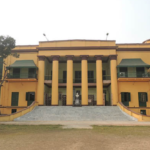In the rich tapestry of Bengal’s cultural heritage, Nouka Baich, or traditional boat racing, holds a special place. These vibrant and exhilarating races were once a common sight on the rivers of Bengal, including the Hooghly River that flows alongside Uttarpara. The tradition of Nouka Baich in Uttarpara reflects the town’s deep connection to its aquatic landscape and its community’s love for spirited competition and festivity.

The Cultural Significance of Nouka Baich
Nouka Baich, translating to “boat race,” is more than just a sport; it is a celebration of teamwork, strength, and local culture. Historically, these races were held during festivals and special occasions, drawing large crowds from neighboring villages and towns. The races were a testament to the skill and endurance of the boatmen, as well as a display of the community’s unity and festive spirit.
Usually, Nauka baich takes place on the day of Manasa Devi Immersion. Manasa Devi is a fierce pre-aryan deity who protects her devotees against snake bites, famines and violent natural calamities. She is seen as a protector of children and fertility. Manasa Magla Kavya circa 13 Century has been immortalized in the beautiful painting tradition of Patachitra “scroll paintings” by the Patuas in Bengal.[ii] In the story of Manasa-Behula too, river plays an integral part. These are compelling myths: A David and Goliath story of sorts, but one is never sure who is who. The myth of Manasa Devi colors Amitav Ghosh’s novel Gun Island.
A Glorious Past
In the past, the banks of the Hooghly River in Uttarpara would come alive with the excitement and anticipation of Nouka Baich. The races were often organized during the monsoon season when the river was full and the currents were strong, adding an element of challenge to the competition. Teams from different parts of Uttarpara and nearby areas would compete, each representing their village or community.
The boats used in these races, known as “noukas,” were long and slender, designed for speed and agility. Decorated with vibrant colors and often adorned with flags, these boats were a sight to behold as they cut through the water, propelled by the rhythmic rowing of the boatmen.
Community Participation and Festivity
Nouka Baich was a community event in every sense. Preparations for the races would begin weeks in advance, with teams practicing on the river and locals coming together to support and cheer for their favorites. On the day of the race, the riverbanks would be lined with spectators, creating a festive atmosphere filled with music, cheers, and the sounds of traditional instruments.
The races were not just about winning; they were a celebration of community spirit. The participating teams displayed camaraderie and sportsmanship, and the event served as a platform for social interaction and bonding among the residents of Uttarpara.
Decline Of This Glorious Tradition
Over time, the popularity of Nouka Baich in Uttarpara, like in many parts of Bengal, saw a decline. Several factors contributed to this, including changes in lifestyle, modernization, and the advent of new forms of entertainment. The once-thriving tradition gradually faded, leaving behind memories of the joyous celebrations that once were.
Nouka Baich Is Still Alive In The Sundarbans
Memories of Nouka Baich (please see link below)
This year, the race started from Ghusiaghata on the Bidyadhari River near Kolkata on the 17th September, 2022. Both riverbanks bloomed with people who came out to see Nauka Baich after two years, when it could not held due to covid restrictions. Swarupda tells me that Bidyadhari was an important river with a prosperous riverine port, but has desiccated over the years. It has little freshwater now and Kolkata’s sewage flows in the river unchecked. The river further meets Raimangal river in the Sundarbans delta region.
More than 40,000 people gathered on the banks on the first day. The race was organized by Ghusighata Villagers’ Association. The next day, at Malancha the crowd was more than 50,000. Between 17 and 23 September, more than 1.5 lakh people enjoyed the boat races and the Mela (Fair) on the riverbanks! These are majority rural folk: farmers, farm laborers and fisherfolk. Before Jamindari system was abolished in Bengal, boats were paid for by Jamindars and the races ended up being Jamindar’s races. But now, the village associations take up the organization responsibility. It is nearly impossible to keep political parties out of a public event like this, but Swarupda tells me religious tensions are unheard of during the races.
True to its ecological nature, Sunderban region of Bengal holds some of the most complex syncretic traditions which unite not only Hindus and Muslims, but also humans and nature. Same holds for the boat-races. From the boat-makers to paddlers to the people who gather along the banks, there are Hindus, Muslims, tribals together. When I asked this question, Swarupda seemed taken aback: the cultural mix here is so organic that an outsider’s question about it must look peculiar. May this complex togetherness prosper in the lands where rivers meet.
The Future of Nouka Baich in Uttarpara
Sadly, there seems no future of boat race revival in Uttarpara in near future. However, the tradition is still alive in south Bengal – specially Sundarbans region
Source: Boat Races of Bengal: A River Carnival By South Asia Network on Dams, Rivers and People




